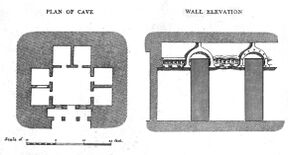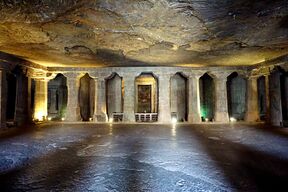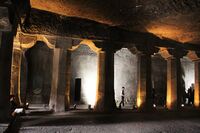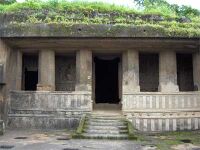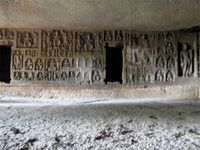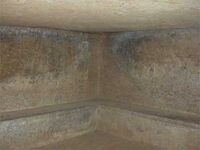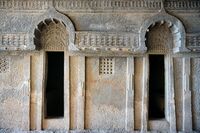ڤيهارا
ڤيهارا Vihara تشير عموماً إلى دير for Buddhist renunciates. The concept is ancient and in early Sanskrit and Pali texts, it meant any arrangement of space or facilities for dwellings .[2][3] The term evolved into an architectural concept wherein it refers to living quarters for monks with an open shared space or courtyard, particularly in Buddhism. The term is also found in Ajivika, Hindu and Jain monastic literature, usually referring to temporary refuge for wandering monks or nuns during the annual Indian monsoons.[2][4][5] In modern Jainism, the monks continue to wander from town to town except during the rainy season (Chaturmas), the term "vihara" refers their wanderings.[6][7]
Vihara or vihara hall has a more specific meaning in the architecture of India, especially ancient Indian rock-cut architecture. Here it means a central hall, with small cells connected to it sometimes with beds carved from the stone. Some have a shrine cell set back at the centre of the back wall, containing a stupa in early examples, or a Buddha statue later. Typical large sites such as the كهوف أجانتا, Aurangabad Caves, كهوف كارلي، و كهوف كانهري contain several viharas. Some included a chaitya or worship hall nearby.[8] The vihara was originated to be a shelter for Monks when it rains.
الأصول
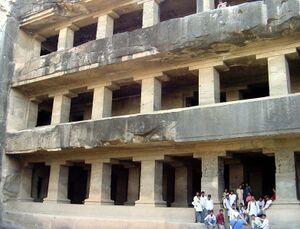
التاريخ
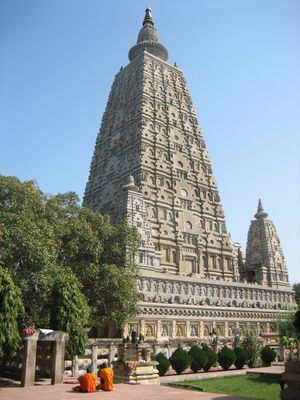
The earliest Buddhist rock-cut cave abodes and sacred places are found in the western Deccan dating back to the 3rd century BCE.[9] These earliest rock-cut caves include the Bhaja Caves، و كهوف كارلا، وبعض كهوف أجانتا.
معرض صور
Cave 4, Ajanta Caves
Entrance to a vihara hall at Kanheri Caves
Doorways of a Vihara, Bedse Caves
انظر أيضاً
- Brahma-vihara
- List of Buddhist temples
- Nava Vihara
- Wat – a Buddhist temple in Cambodia, Laos or Thailand.
- Gompa
الهامش
- ^ Sharon La Boda (1994). International Dictionary of Historic Places: Asia and Oceania. Taylor & Francis. p. 625. ISBN 978-1-884964-04-6.
- ^ أ ب خطأ استشهاد: وسم
<ref>غير صحيح؛ لا نص تم توفيره للمراجع المسماةmmwvihara - ^ خطأ استشهاد: وسم
<ref>غير صحيح؛ لا نص تم توفيره للمراجع المسماةLahiri2015p181 - ^ خطأ استشهاد: وسم
<ref>غير صحيح؛ لا نص تم توفيره للمراجع المسماةKramrisch1946p137 - ^ Paul Dundas (2003). The Jains. Routledge. pp. 203–204. ISBN 1-134-50165-X.
- ^ Gomaṭeśvara sahasrābdī mahotsava darśana, Niraj Jain, Śravaṇabelagola Digambara Jaina Muzaraī Insṭīṭyuśaṃsa Mainejiṅga Kameṭī, 1984, p. 265
- ^ Tulasī prajñā, Jaina Viśva Bhāratī, 1984, p. 29
- ^ Michell, George, The Penguin Guide to the Monuments of India, Volume 1: Buddhist, Jain, Hindu, p. 67 and see individual entries, 1989, Penguin Books, ISBN 0140081445
- ^ Thapar, Binda (2004). Introduction to Indian Architecture. Singapore: Periplus Editions. p. 34. ISBN 0-7946-0011-5.
المراجع
- Chakrabarti, Dilip K. (October 1995). "Buddhist Sites across South Asia as Influenced by Political and Economic Forces". World Archaeology. 27 (2): 185–202. doi:10.1080/00438243.1995.9980303. JSTOR 125081.
- Harle, J.C., The Art and Architecture of the Indian Subcontinent, 2nd edn. 1994, Yale University Press Pelican History of Art, ISBN 0300062176
- Khettry, Sarita (2006). Buddhism in North-Western India: Up to C. A.D. 650. Kolkata: R.N. Bhattacharya. ISBN 978-81-87661-57-3.
- Michell, George, The Penguin Guide to the Monuments of India, Volume 1: Buddhist, Jain, Hindu, 1989, Penguin Books, ISBN 0140081445
- Mitra, D. (1971). Buddhist Monuments. Calcutta: Sahitya Samsad. ISBN 0-89684-490-0.
- Rajan, K.V. Soundara (1998). Rock-cut Temple Styles: Early Pandyan Art and The Ellora Shrines. Mumbai: Somaiya Publications. ISBN 81-7039-218-7.
- Tadgell, C. (1990). The History of Architecture in India: From the Dawn of Civilization to the End of the Raj. London: Phaidon. ISBN 1-85454-350-4.
وصلات خارجية
- Lay Buddhist Practice: The Rains Residence – A short article on the meaning of Vassa, and its observation by lay Buddhists.
- Mapping Buddhist Monasteries A project aiming to catalogue, crosscheck, verify and interrelate, tag and georeference, chronoreference and map online (using KML markup & Google Maps technology).
